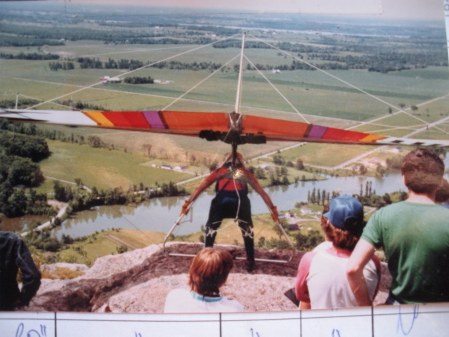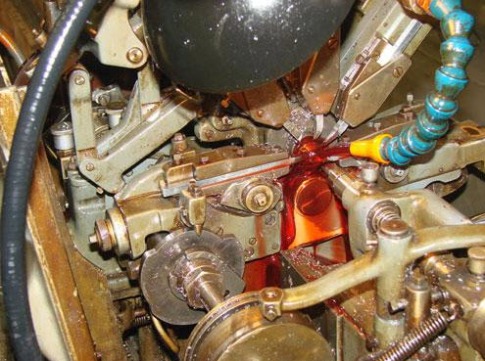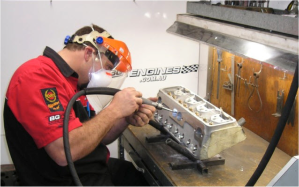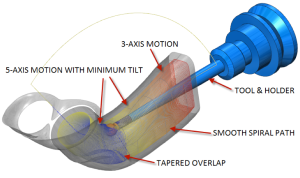I first landed in Canada on a Friday afternoon in September of 1979.
Started working 60 hour weeks the next Monday in a machine shop. I spoke Hungarian, Croatian and German but not a word of English. The only language that helped me was the universal one – Math. My schooling was not recognized here but hard work was. Work kept me busy but I was in THE country best known about its outdoors so I quickly got addicted to the true freedom that I have never experienced before . . .
It was July 3 1982. I was standing on top of the 750 feet King Mountain, Ottawa, Canada. A cold front just moved through from the West just yesterday.The sky was clear with only a few, young cumulus floating in a light,summer breeze. It was still early, later on they will become large, sitting on powerful thermals. The Blue Angels just flew by in their formation just a few minutes ago as the Canada day celebrations where winding down.
I was going through my pre-flight inspection. My hang-glider was in great condition but every pilot goes through this routine methodically. Check all the flying wires, make sure that they are not frayed, check all the bolts and nuts, check every inch of the sail, feel the leading edge for any imperfection, make sure that all the batons are secured.
This is very similar to doing the last check on your tooling and set-up. Make sure that the tools are sharp,the inserts are tightened just right,the fixture is rigid and the part is secure, just before you press cycle start – except your life is not depending on one mistake.
The next step is to hook-in to the center of gravity with an over-sized carabiner. Do a hang-check. Stand-up and feel the glider in the light breeze. It all feels fine. Walk to the top of the large, round, rock-face terminating in a 500 foot dead cliff.
O.K. my heart is racing now! I’ve logged 56 flights so far, but the total airtime is only 19 minutes. My highest flight to date was a mere 120 foot hill, where my flight path followed the slope in such a way that I was never more than 30 to 50 feet above ground. This is wild, OK so remember the flight-plan: Hold the glider straight and level, keep the nose low, but not too low, wait for a steady breeze, watch the breeze playing in the bushes as it comes at you . . .
Am I sill hooked-in? Yes. Yell “Clear!” and run like hell towards the abyss.
The next thing I know is I’m flying. All I hear is just the reassuring sound of the wind rushing past my sail, it sounds a bit fast so I slow down slightly. Wow there is all this room all this altitude. I can finally start practicing some 180 degree turns, maybe even a 360. This is so much fun, let’s try another turn . . . now I feel what is ‘Learning to Fly’ by Pink Floyd is all about . . .
Ugh – oh I need to pay attention! The forest bellow looks way too close! I supposed to fly over the river to the landing filed. I’m not going to make it! Don’t panic there is a nice field on this side of the river, all I have to do is fly across that gap in the tree-line and I’ll be fine. Getting closer to the gap. Not sure if it is wide enough for my wing-span but I will bank slightly when I go through . . . closer now, it looks wide enough, remember to keep your speed up. Wow!! – I just saw the sun reflecting off an electrical wire in that gap! I am doing about 40 mph at about 30 feet above the ground heading for an electrical wire! There are no brakes, I cannot dive into the ground, if I try to hop over I will stall at 70 feet above the ground and dive in at 60 mph!
I’m so glad I learned all that math! None of it helps me now! Instinct takes over, I bank hard right and push the A-frame all the way out . . . the glider goes into a complete stall with the wings vertical just as I hit the big tree on the right side of the gap. I hold on to the branches at about 50 feet from the ground and wait for the farmer and then a half hour later my buddies to help me out of my predicament.
I am so happy, I can’t wait to do this again . . . well not the landing in the tree part. It is OK to make mistakes if you can learn from them and it helps if you survive them:-)
The whole flight only lasted 5 minutes and 28 seconds but I still remember it vividly 30 years later.




 Posted by karloapro
Posted by karloapro 








